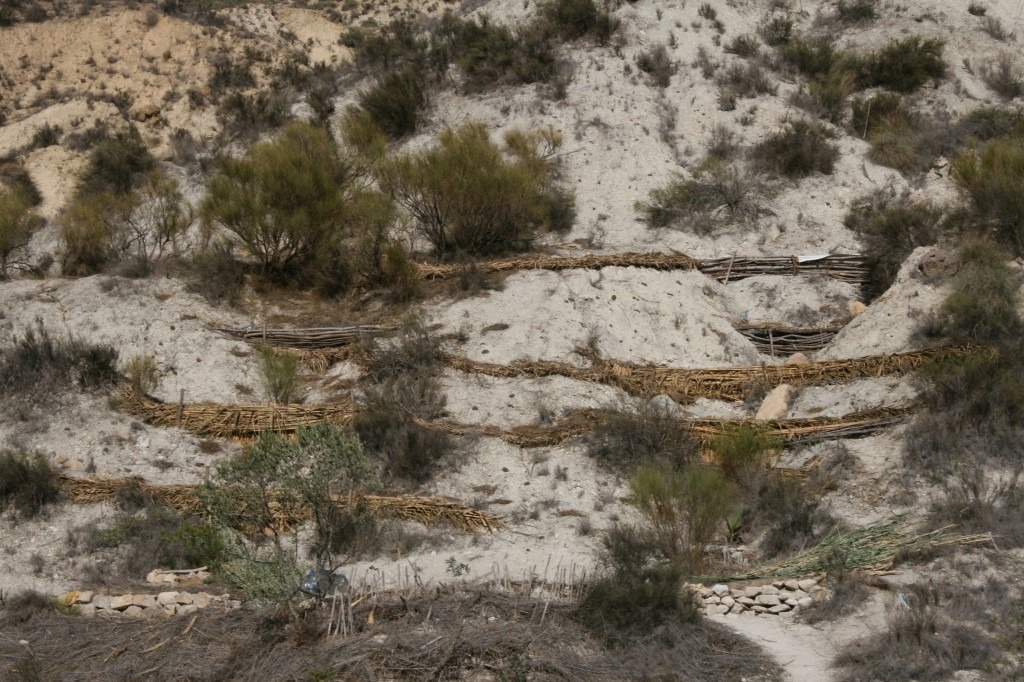Drylands Management, Tutorial
After a series of interventions in Arizona’s land, we have done the ultimate one!
In the two gullies in the plot, we have built reed and woody barriers to stop soil erosion. The barriers have been interconnected through reed biorolls which were placed using the Key Line technique, addressing the water from the gullies to the slopes to make it more accessible for the plants in them at the same time that erosion is reduce too. Plants have been planted behind the barriers and along the biorolls adding compost as nutrient resource and cactus as water resource. The holes were filled up with water before planting and all has been covered with mulch.
It is interesting to know that those plants that had been for too long in a pot need regular watering and in order to face that the following was done:
Bottles of five liters had a hole made in the bottom with a hot metal stick. This hole shouldn’t be bigger than the thickness of the rope that is going to be put in and laid around the bottom of the plant hole. Once the rope is properly glued to the bottle, it’s filled up with water and and placed in the plant hole. By leaving the lid half opened the water will be driven out of the water bottle to the soil along the rope when it is dry keeping a balance of dampness between the two environments, basically an osmosis process.
Below the gullies there is a flat area where some work has taken place too.
Trenches were dug taking into account the entrance of water from the gullies (as ripples created by a rock thrown into a pond) and with the same technique applied to the bio-rolls pursuing similar effect. The arriving water filters through and gets absorbed by vegetation planted in the terraces built along them. Along the terraces a mound like pile of earth was created as protection for the planting.
The area between and in the terraces was covered with mulching as in the gullies.
The plants used for this last intervention were mastic (Pistacia lentiscus), retama (Retama sphaerocarpa), olive trees (Olea europaea), rosemary (Rosmarinus officinalis), efedra (Ephedra fragilis) and carob trees (Ceratonia siliqua).
Lastly, another project was carried out in Alan’s land, a nearby Sunseed’s plot:
Retama is a plant that has a symbiosis relationship with a mycorrhiza found in the soil. Six plants have been planted near an adult retama, and another six far from retama and any other plant. The growth is going to be monitor to see the development of both groups.
Después de una serie de intervenciones en la parcela de Arizona ya hemos terminado la última!
En las dos cárcavas de la parcela hemos construido barreras de caña y ramas de granado e higuera para parar la erosión del suelo. Las barreras están interconectadas con biorrollos de caña que fueron colocados según la técnica de la Línea Clave, redirigiendo el agua de las cárcavas hacia las laderas haciendo que ésta sea más accesible para las plantas en esa área y reduciendo así la erosión en las cárcavas al mismo tiempo. Se han plantado plantas detrás de las barreras y a lo largo de los biorrollos añadiendo compostaje como fuente de nutrientes y chumba como fuente de agua. Los agujeros preparados para plantar se rellenaron de agua antes de poner la planta y todo se cubrió con acolchado.

Es interesante saber que aquellas plantas que habían estado por mucho tiempo en una maceta necesitan que sean regadas regularmente y para arreglar esa situación se hizo lo siguiente:
Se agujerearon por el fondo botellas de agua de cinco litros con una barra de metal caliente. El agujero no debe de ser más ancho que la cuerda que se va a colocar desde ese punto y el suelo en el agujero alrededor de la planta. Una vez que la cuerda se pega correctamente a la botella, ésta se llena con agua y se coloca en el agujero de la planta. Dejando la tapa de la botella medio abierta, el agua se trasladará de la botella al medio externo cuando éste se seque para mantener un balance de agua entre los dos medios, básicamente se trata de un proceso de ósmosis.
A los pies de las cárcavas hay un área llana donde también se ha estado trabajando. Se cavaron zanjas teniendo en cuenta la entrada de agua desde las cárcavas (como olas creadas por una piedra que se tira a un estanque) y con el mismo gradiente impuesto a los biorrollos, buscando el mismo efecto. El agua se filtraría en las zanjas y sería absorbida por las plantas que se han plantado en las terrazas. A lo largo de las terrazas se trazó una línea como un montículo de arena como protección para las plantas.
El área entre y en las terrazas se cubrió con acolchado igual que en las cárcavas.
Las especies utilizadas en esta intervención han sido el lentisco (Pistacia lentiscus), retama (Retama sphaerocarpa), olivos (Olea europaea), el romero (Rosmarinus officinalis), efedra (Ephedra fragilis) y algarrobos (Ceratonia siliqua),
Por último, a la misma vez que este proyecto, otro se llevó a cabo en la parcela de Alan, cerca de Arizona:
La retama es una planta que establece una simbiosis con la micorriza que se encuentra en el suelo. Seis retamas se plantaron cerca de una retama adulta y otras seis se plantaron lejos de retamas y cualquier otra planta. El crecimiento de estos dos grupos va a ser monitoreado para ver el desarrollo de los mismos.














